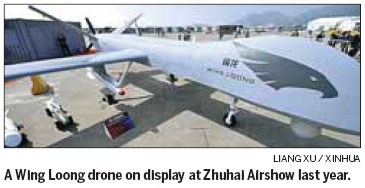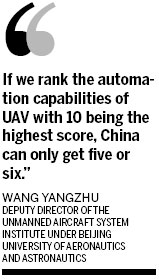Nations look to buy drones from China
Updated: 2013-06-20 07:36
By Zhao Lei in Paris (China Daily)
|
||||||||


Technological advances have made unmanned vehicle an attractive deal
At least five countries are negotiating with China on buying its domestically developed Wing Loong drone.
"Wing Loong is quite competitive in the international market and we have delivered it to up to three clients," Ma Zhiping, general manager of China National Aero-Technology Import and Export Corp, said at the 50th International Paris Air Show.
Ma's company is the biggest exporter of aviation defense products in China and has a strong presence in the military aircraft market. It belongs to Aviation Industry Corp of China, the country's leading aircraft manufacturer.
Established in 1909, the Paris Air Show is held every odd-numbered year at Le Bourget Airport in north Paris. This year's show started on Monday and will last through Sunday.
Ma said clients' feedback on Wing Loong is "very positive".
"They told us that they are satisfied with the drone's performance. Their uses of the Wing Loong have testified to its excellent combat capability, supreme maneuverability as well as convenience of maintenance," he said, quoting users as saying that the drone's actual performance has "surpassed its design specifications".
According to CATIC, Wing Loong was developed independently by China with full intellectual property to meet the requirement of the international market. The project was started in 2005 and its maiden flight took place in 2007. The drone's mockup was unveiled at the Zhuhai Airshow in 2008 and a production type was displayed at the same air show in 2012, drawing intense attention from aviation enthusiasts and foreign military observers.
It can perform a wide range of tasks such as precision strikes and long-duration, long-distance reconnaissance. In June 2006, the government gave the green light to its export.
In addition to military purposes, the unmanned aerial vehicle can also serve an array of civil and scientific purposes such as disaster assessment, environmental protection, and atmospheric and meteorological research, the company said.
The drone boasts a range of more than 3,000 kilometers and a payload of 200 kilograms.
All the techniques used on Wing Loong were developed by Chinese researchers without any foreign assistance, said Nie Haitao, deputy director of AVIC Chengdu Aircraft Design and Research Institute, which designed the drone.
"In the initial stage of Wing Loong's development, only nine researchers were designated to take part in this work and most of them were young professionals without much experience," he recalled. "Yet they succeeded and now you can see they have done a good job."
The United Arab Emirates and Uzbekistan have introduced an unidentified number of Wing Loong drones, according to Kanwa Defense Review, a Canadian online magazine of defense affairs and weapon technology.
"Currently five to six nations in Africa and Asia have expressed their intention of buying Wing Loong and we are negotiating over that," Ma said.
He added several foreign countries have told his company that they want to introduce Chinese drones that are even more advanced than Wing Loong, but whether those types could be exported is up to government policy and political decisions.
"Of course we, as a defense products supplier, are willing to introduce more of our cutting-edge weapons to the international market. But it is the government that has the final say."
Seeing a bright picture of Chinese drones in the global market, aviation experts said people should be reminded that China still lags behind in many aspects in the UAV industry.
China is still unable to produce an unmanned aerial vehicle that can rival the United States' RQ-4 Global Hawk, according to Wang Yangzhu, deputy director of the Unmanned Aircraft System Institute under Beijing University of Aeronautics and Astronautics.
"If we rank the automation capabilities of UAV with 10 being the highest score, China can only get five or six," he said.
"The capability of a UAV should not be judged merely by its speed and altitude, its ability in performing varied missions makes more sense."
Wang's institute is one of the three academic institutes in China that specialize in UAVs. The other two are in Nanjing University of Aeronautics and Astronautics in Jiangsu province and Northwestern Polytechnical University in Shaanxi province.
He said China's efforts to develop advanced drones are being haunted by a long-time inability in resolving some key technologies including engines and data links, noting the country's aviation industry needs to solve a host of technical blocks.
"Though we are able to manufacture UAVs on our own, we can't produce those as advanced as the RQ-4 Global Hawk, which is now the top drone before the Northrop Grumman X-47B enters into service. The most outstanding obstacle confronting us remains the engine problem."
He explained that the data link and airborne electronic devices used on Chinese drones still lag behind those of their US counterparts.
In contrast to Wang's words, many foreign military observers said Chinese drones are fairly competitive in the international market in terms of technical characteristics, performance and price.
Wendell Minnick, Asia bureau chief at Defense News, said in an earlier report on VOA's website that Chinese drones, many of which are specifically produced for the export market, are very attractive for many developing nations.
"(The US) drone exports are very expensive platforms, very sophisticated. The Chinese produce a much cheaper variety that basically does the same job," said Minnick. "The Chinese ... are looking at an export market that's growing."
"China has ramped up research in recent years faster than any other country. It displayed its first unmanned system model at the Zhuhai air show five years ago, and now every major manufacturer for the Chinese military has a research center devoted to unmanned systems," a report published in July by the Defense Science Board, an experts panel charged with advising the US Department of Defense on scientific and technical issues, was quoted by The New York Times as saying.
"(China) could ... rapidly close the technology gaps and become a formidable global competitor in unmanned systems."
zhaolei@chinadaily.com.cn
(China Daily USA 06/20/2013 page1)

 Michelle lays roses at site along Berlin Wall
Michelle lays roses at site along Berlin Wall
 Historic space lecture in Tiangong-1 commences
Historic space lecture in Tiangong-1 commences
 'Sopranos' Star James Gandolfini dead at 51
'Sopranos' Star James Gandolfini dead at 51
 UN: Number of refugees hits 18-year high
UN: Number of refugees hits 18-year high
 Slide: Jet exercises from aircraft carrier
Slide: Jet exercises from aircraft carrier
 Talks establish fishery hotline
Talks establish fishery hotline
 Foreign buyers eye Chinese drones
Foreign buyers eye Chinese drones
 UN chief hails China's peacekeepers
UN chief hails China's peacekeepers
Most Viewed
Editor's Picks

|

|

|

|

|

|
Today's Top News
Shenzhou X astronaut gives lecture today
US told to reassess duties on Chinese paper
Chinese seek greater share of satellite market
Russia rejects Obama's nuke cut proposal
US immigration bill sees Senate breakthrough
Brazilian cities revoke fare hikes
Moody's warns on China's local govt debt
Air quality in major cities drops in May
US Weekly

|

|







